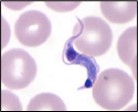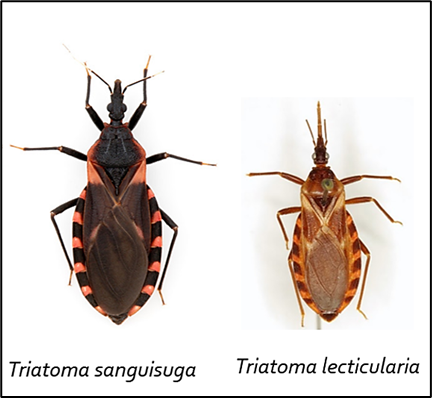Samantha Wisely, Professor of Wildlife Ecology and Wildlife Extension Specialist, University of Florida, & Norman Beatty, Assistant Professor, Infectious Diseases and Global Medicine, University of Florida
What is Chagas disease?

Figure 1. The parasite, Trypanosoma cruzi, surrounded by red blood cells. Photo courtesy of the CDC.
Chagas disease is a debilitating infection caused by the parasite, Trypanosoma cruzi (Figure 1). The parasite is found inside kissing bugs (Figure 2.) and can be passed to people via the bug’s feces. If infected kissing bug feces comes into contact with a mucus membrane near your eye or mouth, or even a break in the skin, the parasite can be transmitted to humans. People and pets can also ingest food or drink that has been contaminated with bug feces, which can cause infection. Chagas disease often goes undiagnosed, because the majority of those infected show no symptoms for decades, but the chronic disease can be serious and even fatal. Infection typically affects the heart and/or the gastrointestinal tract which can lead to electrical problems with the heart, congestive heart failure or enlarged colon. Some symptoms include palpitations or sensation of irregular heartbeats, difficulty swallowing, swelling in the legs, or distended abdomen. For a complete list of symptoms refer to the CDC’s website on Chagas disease: https://www.cdc.gov/parasites/chagas/.
The parasite maintains itself in the environment through a cycle that involves kissing bugs and mammals transmitting the parasite back and forth. Kissing bugs feed on the blood of mammals, reptiles, amphibians and birds, but only mammals can carry the parasite. In the U.S., typical mammals that carry the parasite include raccoons, opossums, dogs, rodents, and armadillos. The parasite travels in the bloodstream to organs (usually the heart or gastrointestinal tract) where it embeds and causes tissue damage and disease. While in the bloodstream, the parasite can be transmitted to blood feeding kissing bugs who then transmit it to other mammal hosts.

Figure 2. Two species of kissing bug are found in Florida. Triatoma sanguisuga has a distinct black and orange striping, and can be found in at least 32 of Florida’s 67 counties. Photo courtesy of Norman Beatty, University of Florida.
Two species of kissing bug are commonly found in Florida (Figure 2). Triatoma sanguisuga has a distinct black and orange striping, and can be found in at least 32 of Florida’s 67 counties. Triatoma sanguisuga is the most common kissing bug species and is attracted to homes in rural Florida. With more awareness of kissing bug invasion into homes in Florida, at least 50 people have reached out to the UF Chaga’s Disease Team to learn more about Chagas disease in the last 2 years.
–
Who is at risk?
In the Florida Panhandle, three populations are at risk for Chagas disease: Latin American’s who have emigrated from Mexico, Central and South America, rural people, and domestic dogs that live outdoors. Let’s take a closer look at these three populations.
- Latin Americans living in the US
In Mexico, Central and South America, it is estimated that 6-7 million people are living with Chagas disease. People may immigrate to the U.S. without showing symptoms, but years later develop the disease. This population represents the largest group of people living with Chagas disease in the U.S. The parasite can also be passed down from mother to child during pregnancy, so children whose mothers emigrated from Latin America may potentially be at risk as well.
– - Rural People in the Southeastern U.S.
Kissing bugs naturally live in or near forested regions of the south. They are attracted to houses that have large woodpiles, chicken coops, livestock, and dog kennels. Kissing bugs feed on animals, so having these attractants near the home can increase the risk of kissing bug invasion into the home. This can lead to kissing bug bites and possible exposure to bug feces. In addition to exposing people to the parasite, kissing bug bites can produce a severe allergic reaction in some people called anaphylaxis.
– - Rural Dogs in the Southeastern U.S.
Dogs that live in outdoor kennels can get Chagas disease both by being bitten by kissing bugs and/or from eating kissing bugs. Like humans, dogs can develop heart or gut complications from this disease.
–
How can I reduce the risk of contact with kissing bugs?
- Remove wood piles, leaf litter, or rocks near homes
- Keep chicken coops and roosts away from the house
- Screen all windows and doors, and seal up all cracks
- Use yellow emitting bulbs outside the home and not fluorescent
- Contact local pest exterminators for residual pesticide outside the home
- Use air conditioning during summer months rather than open air ventilation
- Keep dog kennels away from the house and be sure to clean kennels regularly
- If sleeping outdoors or in homes where one suspects the presence of kissing bugs, use mosquito netting over the bed
–
Should I be tested for Chagas disease?
If you or your mother are from a Latin American country where the parasite is naturally being transmitted, you should be screened for Chagas Disease. In addition, if you suspect that you have been bitten by a kissing bug, or find kissing bugs in your home, you should consider being tested. The test requires a simple blood sample. Similar tests are available for dogs, if you suspect they have been bitten or exposed to kissing bugs.
–
How can I find out more about Chagas disease or have a kissing bug identified?
The University of Florida College of Medicine has an infectious disease specialist, Dr. Norman Beatty, who can help you determine if you should be tested and to recommend treatments if you have Chagas disease.
For more information about Chagas disease and how to be tested locally, visit the UF Health Chagas Disease website.
If you are interested in knowing if a bug you have found in your home is a kissing bug, you can submit it for identification. Please send an email to get more information: kissing-bug@ufl.edu
The CDC also has good information on their website for Chagas Disease Symptoms
- How Landowners Can Help Gopher Tortoise Conservation in the Florida Panhandle - August 29, 2025
- Armadillo Biology, Management, and Disease in the Panhandle - February 21, 2025
- Crop Damage from Deer in the Panhandle - August 15, 2024
